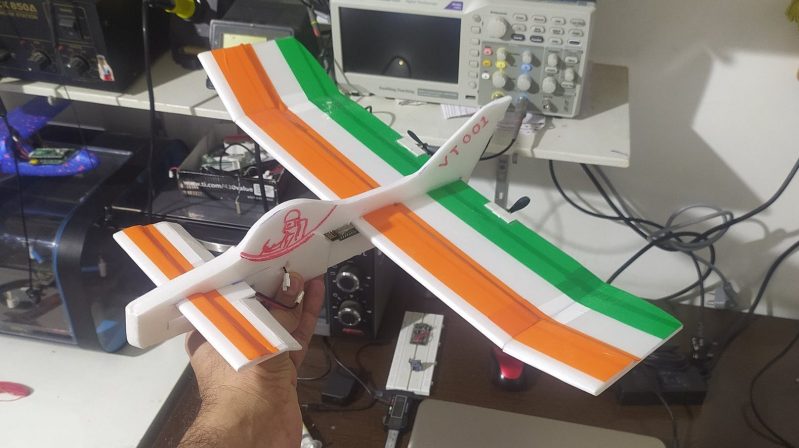Once upon a time, a radio controlled plane was a hefty and complex thing. They required small nitro engines, support equipment, and relatively heavy RC electronics. Times have changed since then, as this lightweight RC build from [Ravi Butani] demonstrates.
 The body of the plane is lightweight foam, and can be assembled in two ways. There’s a relatively conventional layout, using a main wing, tailplane, and rudder, or a pusher model with the main wing at the rear and a canard up front. The open hardware electronics package, which [Ravi] calls VIMANA, consists of an ESP12 module with a pair of MOSFETs to act as two independent motor drivers — allowing the plane to be flown and steered with differential thrust.
The body of the plane is lightweight foam, and can be assembled in two ways. There’s a relatively conventional layout, using a main wing, tailplane, and rudder, or a pusher model with the main wing at the rear and a canard up front. The open hardware electronics package, which [Ravi] calls VIMANA, consists of an ESP12 module with a pair of MOSFETs to act as two independent motor drivers — allowing the plane to be flown and steered with differential thrust.
For more advanced flight control, it can also command a pair of servos to control ailerons, a rudder, canards, or elevons, depending on configuration. There’s also potential to install an IMU to set the plane up with flight stabilization routines.
Thanks to the low-cost of the VIMANA board, [Ravi] hopes it can be used in STEM education programs. He notes that it’s not limited just to aircraft, and could be used for other motorized projects such as boats and cars. We’ve featured an early version of his work before, but the project has come a long way since then.

















Really cool
Before RC planes (radio-controlled planes), there were wire-based RC models (remote controlled planes). I’m not kidding.
They were called Fesselflugzeuge or captive planes.
Operating them was (is) an art in its own reign.
https://en.wikipedia.org/wiki/Captive_plane
Control-line was quite common from the forties on. Often the first exposure of a kid to a gas-powered model aircraft was a cheap plastic Cox or Wen-Mac CL airplane from the toy store. Enthusiasts built fast and powerful CL planes, and CL carrier was even a thing.
Great project!
What about the range/distance it can fly? Isn’t it limited by the WiFi range?
Taested Range of plane with WiFi is almost 130m-150m LOS on my university ground with crowded WiFi spectrum..
no worries of losing plane if it gets out of WiFi range or low battery situation as failsafe mode integrated in firmware and plane will glides to ground by circling with no power on engine in such case..
To increase range external Sbus/Ibus based standard radio controller can be used as plug and play option..
Sounds perfect. Good to have this ‘failsafe mode’. Maybe an eject pilot with parachute can be a life saving feature as well ;)
No, definitely no parachute. Then the pilot leaves the plane on the first problem, instead of trying to land without signal.
Yes… Kept auxiliary channels of board to do such crazy things… :)
Operating on normal wifi mode, or espressif’s Long-Range (low bandwidth) mode?
Current firmware supports normal wifi mode.. vimana board act as Access point.. and smartphone as wifi client..as it’s not esp to esp link..
Super interested to see this project. After seeing Powerup 4.0, I really wanted to make a similar version using ESP8266.
This looks like it is 1/5th the cost of a Powerup 4.0
(which nfortunately, is not easily available in India at the moment.)
I’ll be following the progress, and possibly even build this myself.
As someone who dabbled in RC planes in the ’80s, the advancement since then is astonishing. This looks neat.
Love the Ancient Flying/Alien/Craft reference or “Vimana”!